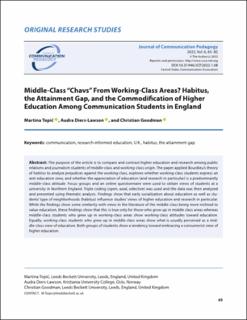| dc.contributor.author | Diers-Lawson, Audra | |
| dc.contributor.author | Goodman, Christian | |
| dc.contributor.author | Topić, Martina | |
| dc.date.accessioned | 2023-03-10T13:19:42Z | |
| dc.date.available | 2023-03-10T13:19:42Z | |
| dc.date.created | 2022-10-17T14:39:30Z | |
| dc.date.issued | 2022 | |
| dc.identifier.citation | Journal of Communication Pedagogy. 2022, 6, 65-82. | en_US |
| dc.identifier.issn | 2578-2568 | |
| dc.identifier.uri | https://hdl.handle.net/11250/3057739 | |
| dc.description.abstract | The purpose of the article is to compare and contrast higher education and research among public
relations and journalism students of middle-class and working-class origin. The paper applied Bourdieu’s theory of habitus to analyze prejudices against the working class, explores whether working-class students express an anti-education view, and whether the appreciation of education (and research in particular) is a predominantly middle-class attitude. Focus groups and an online questionnaire were used to obtain views of students at a university in Northern England. Triple coding (open, axial, selective) was used and the data was then analyzed and presented using thematic analysis. Findings show that early socialization about education as well as students’ type of neighborhoods (habitus) influence studies’ views of higher education and research in particular. While the findings show some similarity with views in the literature of the middle-class being more inclined to value education, these findings show that this is true only for those who grow up in middle class areas whereas middle-class students who grew up in working-class areas show working-class attitudes toward education. Equally, working-class students who grew up in middle-class areas show what is usually perceived as a middle-class view of education. Both groups of students show a tendency toward embracing a consumerist view of higher education. | en_US |
| dc.language.iso | eng | en_US |
| dc.rights | Attribution-NonCommercial-NoDerivatives 4.0 Internasjonal | * |
| dc.rights.uri | http://creativecommons.org/licenses/by-nc-nd/4.0/deed.no | * |
| dc.subject | habitus | en_US |
| dc.subject | higher education | en_US |
| dc.subject | høyere utdanning | en_US |
| dc.subject | klasseforskjeller | en_US |
| dc.subject | class differences | en_US |
| dc.title | Middle-Class “Chavs” From Working-Class Areas? Habitus, the Attainment Gap, and the Commodification of Higher Education Among Communication Students in England | en_US |
| dc.title.alternative | Middle-Class “Chavs” From Working-Class Areas? Habitus, the Attainment Gap, and the Commodification of Higher Education Among Communication Students in England | en_US |
| dc.type | Peer reviewed | en_US |
| dc.type | Journal article | en_US |
| dc.description.version | publishedVersion | en_US |
| dc.source.pagenumber | 65-82 | en_US |
| dc.source.volume | 6 | en_US |
| dc.source.journal | Journal of Communication Pedagogy | en_US |
| dc.identifier.doi | 10.31446/JCP.2022.1.08 | |
| dc.identifier.cristin | 2062087 | |
| cristin.ispublished | false | |
| cristin.fulltext | original | |

